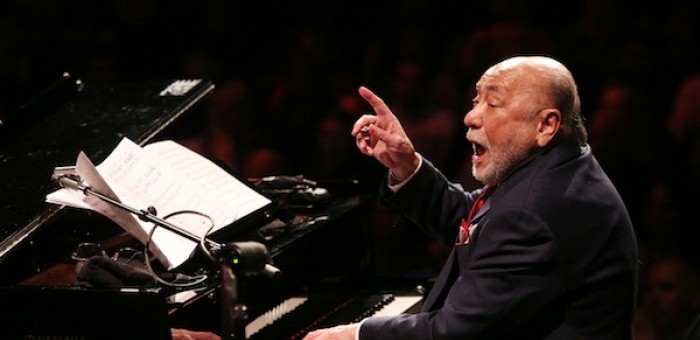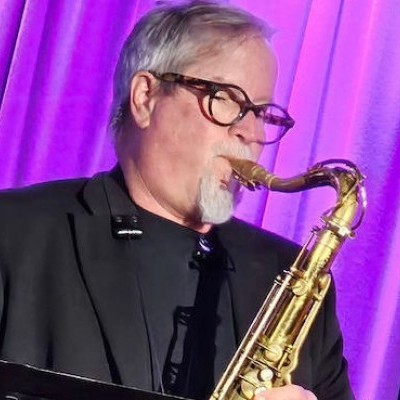Oct 28, 2025 10:47 AM
In Memoriam: Jack DeJohnette, 1942–2025
Jack DeJohnette, a bold and resourceful drummer and NEA Jazz Master who forged a unique vocabulary on the kit over his…

Eddie Palmieri, who turned 80 in December 2016, celebrated becoming an octogenarian with a concert at Jazz at Lincoln Center in New York City on March 3.
(Photo: Ayano Hisa)Long hailed as “the Sun of Latin Music” (a moniker taken from his 1974 album of the same name), Eddie Palmieri has endured to become the genre’s most acclaimed living star. He the patriarch of an increasingly popular music, the roots of which reach back to Africa and the Caribbean but have since branched out to all over the world.
As part of a yearlong tour— dubbed EP@80 and celebrating his landmark Dec. 15, 2016, birthday—the 10 time Grammy Award-winning pianist brought an expanded ensemble to Jazz at Lincoln Center’s Rose Hall on March 3 for a multifaceted program, Eddie Palmieri: Celebrating 80 Years, that revisited some of the hugely popular pieces from the octogenarian’s expansive repertoire and presented inventive new works from his upcoming album, Sabiduría (Ropeadope).
Stepping out from stage right on to the “House Of Swing” bandstand, the beaming Palmieri, with a youthfulness belying his age, received an extended standing ovation from the packed house, which that night happened to include fellow NEA Jazz Masters Lee Konitz and Roy Haynes.
Taking his seat at a Yamaha Avant Grand piano, Palmieri got things started on a forward-looking note, with an unaccompanied performance of one of his more recent compositions, “Life,” a flowing, harmonically rich reflection dedicated to his late spouse. Accented with emotional vocal cries, it ended on a sustained bottom register chord.
Palmieri informed the audience about the providence of his music, its place in the continuum of the pioneering Afro-Cuban sounds of the “Big Three”—Machito, Tito Puente and Tito Rodriguez—and its continued evolution into the world of jazz under the influence of his heroes, Thelonious Monk, McCoy Tyner and Herbie Hancock.
A dozen instrumentalists comprised Palmieri’s powerful ensemble, including an eight-piece horn section of trumpeters Brian Lynch, Jonathan Powell and Charlie Sepulveda, trombonists Jimmy Bosch and Doug Beavers, and saxophonists Louis Fouche, Jeremy Powell and Ivan Renta and a rhythm section of bassist Luques Curtis and percussionists “Little Johnny” Rivero, Nicky Marrero and Carmen Molino. Their explosive reading of Palmieri’s “Palmas” generated a wall of sound.
The song also featured a bass solo by Curtis that showcased his rich tone and nimble rhythmic acuity. Accentuating that drive was Palmieri’s trademark propulsive chordal comping, which coalesced dynamically around the polyrhythms of Rivero’s congas, Marrero’s timbales and Molino’s drum kit. The groove continued unrelentingly, driving Lynch’s stratospheric statement and Palmieri’s own fiery solo flight.
The pianist’s jazz credentials were fully displayed on his “Bug”, a soulful outing that began with a dark horn introduction, anchored by Renta’s weighty baritone, that recalled Philly Joe Jones’s “Blues For Dracula,” followed by a minor marching interlude redolent of Eric Dolphy’s “Hat And Beard”, before settling into a straightahead groove that served as a swinging foundation for solos by the Powell brothers’ tenor and trumpet and Beaver’s trombone.
Palmieri’s “Spinal Volt” organically merged the composer’s jazz and Latin sensibilities with a flowing melodic line punctuated by sharp rhythmic accents. The group delivered a mambo styled that underinned Renta’s baritone solo, horns riffing behind his flowing lyrical lines. Lynch’s high-flying improvisation climbed to the outer reaches of his horn’s upper register, and was followed by a fat-toned Fouche alto solo that revealed a round yet edgy sound.
Marrero then stepped into the spotlight with an incendiary timbales solo over Palmieri’s indefatigable montuno. As the horns riffed a climactic “Manteca” fragment, the pianist interjected an original melodic line that the horns picked up to close the piece. The pianist then launched into his perennial comparsa break tune to bring the concert’s first half to an exciting close.
Following an intermission Palmieri explained that the concert that began with the band playing what he described as “Latin Jazz” would now switch gears to play music that “guaranteed you’ll be dancing in your seats.” He then introduced the group’s new additions—sonero Herman Olivera as “la voz de Caribe” and tres player Nelson Gonzalez—as his “secret weapon,” along with his son Joe, who filled out the new frontline on maracas and vocal coro.
The newcomers would transform the reconfigured ensemble (with Molino and Marrero moving to timbales and bongo, respectively, and Curtis switching to electric baby bass) into an authentic Latin dance band.
Calling out to friends and family in the audience Palmieri feted one long time fan with a Latin-style version of “Happy Birthday.” The pianist then fired up the band on a version of his classic “Oye Lo Que Te Conviene,” a fiery guaguancó that had audience members singing along with Olivera’s lead vocal and the Gonzalez’s exhorting titular coro. Cheers erupted from the crowd as the individual soloists, most notably Bosch, whose trombone solo hearkened to the sound of Palmieri’s legendary La Perfecta band, stepped out front to play above the churning cadences of the five-man Latin rhythm section.
Palmieri’s classic arrangement of Arsenio Rodriguez’s “Pa Huele” slowed things down to a medium groove, serving as a vehicle for Olivera’s commanding tenor vocals and cleverly improvised Spanish language lyrics that called out with Caribbean imagery, as well as a spellbinding Gonzalez solo over Palmieri’s rolling tumbao rhythm. Things heated up with Bosch and Lynch stepping out front on opposite ends of the stage to trade exhilarating choruses (and choreography) to bring the song to an exciting finish.
Another popular Palmieri composition, “Muñeca,” followed with Olivera belting out the pleading lyric in a call and response pattern with the Gonzalez’s repeated coro of “Perdoname,” as Palmieri rose up from the piano to lead the audience in syncopated 2–3 clave clapping. He returned to the keyboard to deliver an extended solo replete with signature descending lines and minor chord interludes that morphed into an infectious montuno on top of which Rivero soloed on congas. Sepulveda then stepped out front to bring things to a climactic close with a searing upper register excursion.
One more “jazz” instrumental, Palmieri’s “Noble Cruise” (a Herbie Hancock-inspired title dedicated to Thelonious Monk) was heard with Curtis back on acoustic bass and Molino behind the drums delivering a swinging pulse. Following an unaccompanied prelude, Palmieri and Curtis conversed lyrically and Sepulveda’s plunger-muted horn cried out narratively, after which Bosch and Beaver traded choruses before Palmieri took the song’s final solo, then jumped up from the piano to conduct the ensemble’s stop-time tag.
The show concluded with Olivera and Nelson and Joe Gonzales returning to lead the voices on an extended version of Palmieri’s Palladium-era set closer, “Azuca Pa Ti,” that featured raucous round-robin solos by each of the horn sections and scorching percussion interludes that had many audience members (including one very pregnant one) up out of their seats dancing, fulfilling Palmieri’s set opening promise to the crowd, who gave the ever vibrant bandleader a second and well-deserved standing ovation. DB

Jack DeJohnette boasted a musical resume that was as long as it was fearsome.
Oct 28, 2025 10:47 AM
Jack DeJohnette, a bold and resourceful drummer and NEA Jazz Master who forged a unique vocabulary on the kit over his…

“I’ve told students, ‘I don’t mind if you use AI for this or that project,’” says MIT’s Pascal Le Boeuf. “‘But you need to tell me.’”
Sep 18, 2025 11:14 AM
A standard joke when it comes to discussing artificial intelligence, or AI, is that it’s developing so rapidly that…

Chuck Manning Works for NASA … and plays jazz.
Sep 18, 2025 11:23 AM
Congratulations! After years of study, you’ve earned your degree in jazz performance. But let’s face it: Making a…

Gadabout Season developed over many months of recording sessions in Brandee Younger’s East Harlem living room.
Sep 16, 2025 11:52 AM
When she’s on the road, Brandee Younger enters a hybrid state of action and contemplation. Free of daily distractions…

Cleo Laine, 1927–2025
Sep 16, 2025 10:03 AM
The music world mourns the loss of three important artists from the realms of jazz, blues and beyond with the recent…